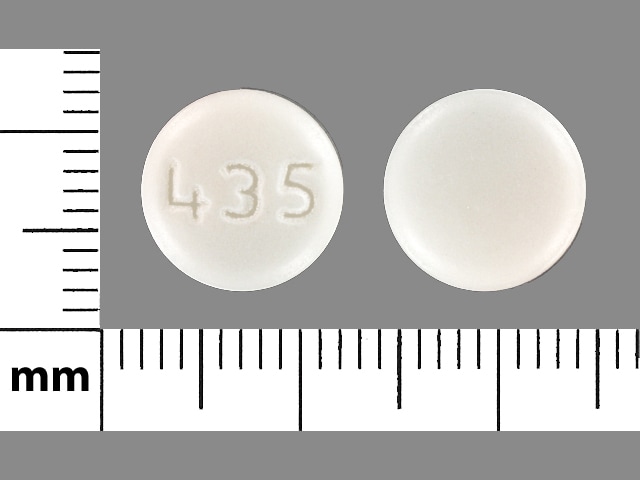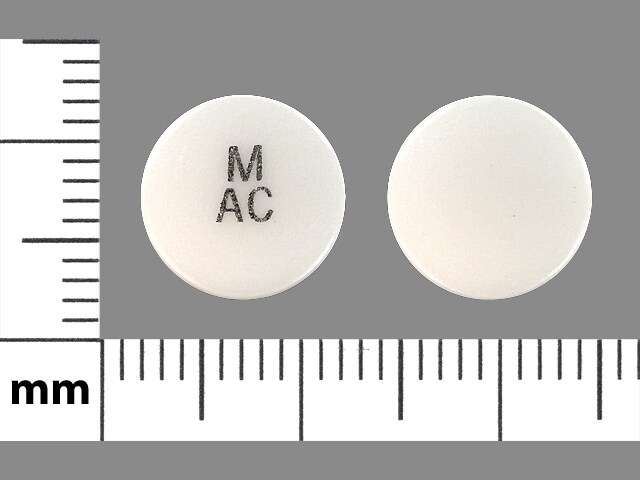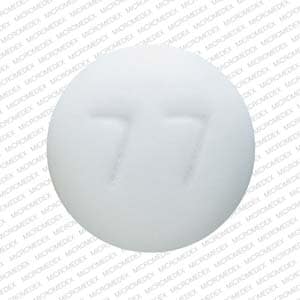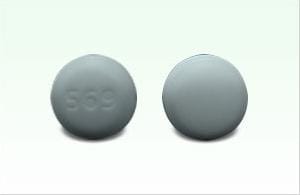Dosage Forms
Excipient information presented when available (limited, particularly for generics); consult specific product labeling.
Tablet Delayed Release, Oral, as calcium:
Generic: 333 mg
Pharmacology
Mechanism of Action
Mechanism not fully defined. Structurally similar to gamma-amino butyric acid (GABA), acamprosate appears to increase the activity of the GABA-ergic system, and decreases activity of glutamate within the CNS, including a decrease in activity at N-methyl D-aspartate (NMDA) receptors; may also affect CNS calcium channels. Restores balance to GABA and glutamate activities which appear to be disrupted in alcohol use disorder. During therapeutic use, reduces alcohol intake, but does not cause a disulfiram-like reaction following alcohol ingestion. Insignificant CNS activity, outside its effect on alcohol use disorder, was observed including no anxiolytic, anticonvulsant, or antidepressant activity.
Pharmacokinetics/Pharmacodynamics
Distribution
Vd: ~1 L/kg
Metabolism
Not metabolized
Excretion
Urine (as unchanged drug)
Time to Peak
Plasma: 3 to 8 hours
Half-Life Elimination
20 to 33 hours
Protein Binding
Negligible
Use in Specific Populations
Special Populations: Renal Function Impairment
Cmax in patients with moderate or severe renal impairment were 2- and 4-fold higher, respectively.
Use: Labeled Indications
Alcohol use disorder: Maintenance of abstinence from alcohol in patients with alcohol use disorder who are abstinent at treatment initiation, as part of a comprehensive management program
Limitations of use: Efficacy has not been demonstrated in subjects who have not undergone detoxification and not achieved alcohol abstinence prior to beginning treatment. Efficacy in promoting abstinence from alcohol in polysubstance abusers has not been adequately assessed.
Contraindications
Hypersensitivity to acamprosate or any component of the formulation; severe renal impairment (CrCl ≤30 mL/minute)
Dosage and Administration
Dosing: Adult
Alcohol use disorder: Oral: 666 mg 3 times daily (a lower dose may be effective in some patients). Note: Treatment should be initiated as soon as possible following the period of alcohol withdrawal when the patient has achieved abstinence and should be maintained if patient relapses.
Dosing: Geriatric
Refer to adult dosing.
Administration
Oral: May be administered without regard to meals (administered with meals during clinical trials to possibly increase compliance). Tablet should be swallowed whole; do not crush or chew.
Dietary Considerations
Abstinence is required for initiation of treatment; however, treatment should be continued in the event of a relapse.
Storage
Store at 25°C (77°F); excursions permitted to 15°C to 30°C (59°F to 86°F).
Acamprosate Images
Drug Interactions
There are no known significant interactions.
Adverse Reactions
Many adverse effects associated with treatment may be related to alcohol abstinence; reported frequency range may overlap with placebo.
>10%: Gastrointestinal: Diarrhea (10% to 17%)
1% to 10%:
Cardiovascular: Chest pain, hypertension, palpitations, peripheral edema, syncope, vasodilation
Central nervous system: Insomnia (6% to 9%), anxiety (5% to 8%), depression (4% to 8%), dizziness (3% to 4%), pain (2% to 4%), paresthesia (2% to 3%), abnormality in thinking, amnesia, attempted suicide, chills, drowsiness, headache
Dermatologic: Pruritus (3% to 4%), diaphoresis (2% to 3%), skin rash
Endocrine & metabolic: Decreased libido, weight gain
Gastrointestinal: Anorexia (2% to 5%), nausea (3% to 4%), flatulence (1% to 4%), xerostomia (1% to 3%), abdominal pain, constipation, dysgeusia, dyspepsia, increased appetite, vomiting
Genitourinary: Impotence
Infection: Infection
Neuromuscular & skeletal: Weakness (5% to 7%), arthralgia, back pain, myalgia, tremor
Ophthalmic: Visual disturbance
Respiratory: Bronchitis, dyspnea, flu-like symptoms, increased cough, pharyngitis, rhinitis
<1%, postmarketing, and/or case reports: Abnormal hepatic function tests, agitation, alopecia, anemia, angina pectoris, asthma, brain disease, colitis, confusion, deafness, diabetes mellitus, duodenal ulcer, eosinophilia, epistaxis, exfoliative dermatitis, fever, gastrointestinal hemorrhage, gout, hallucination, hemorrhage, hepatic cirrhosis, hepatitis, hostility, hyperbilirubinemia, hyperesthesia, hyperglycemia, hypersensitivity reaction, hyperuricemia, hyponatremia, hypotension, hypothyroidism, increased serum creatinine, increased serum transaminases, leukopenia, lymphadenopathy, lymphocytosis, myocardial infarction, nephrolithiasis, neuralgia, ophthalmic inflammation, orthostatic hypotension, pancreatitis, pneumonia, psychoneurosis, psychosis, pulmonary embolism, rectal hemorrhage, renal failure, seizure, skin photosensitivity, suicidal ideation, tachycardia, thrombocytopenia, urticaria, withdrawal syndrome
Warnings/Precautions
Concerns related to adverse effects:
- CNS depression: May cause CNS depression, which may impair physical or mental abilities; patients must be cautioned about performing tasks that require mental alertness (eg, operating machinery or driving).
- Suicidal thinking/behavior: Attempted and completed suicides have occurred in acamprosate-treated patients; use with caution in suicidal ideation. Monitor for depression and/or suicidal thinking.
Disease-related concerns:
- Alcohol use disorder: Appropriate use: Should be used as part of a comprehensive program to treat alcohol use disorder. Treatment should be initiated as soon as possible following the period of alcohol withdrawal, when the patient has achieved abstinence. Acamprosate does not eliminate or diminish the symptoms of alcohol withdrawal.
- Renal impairment: Use with caution and reduce dose in patients with moderate renal impairment (CrCl 30 to 50 mL/minute). Use is contraindicated in patients with severe renal impairment (CrCl ≤30 mL/minute). The American Psychiatric Association alcohol use disorder guidelines recommend that acamprosate should not be used first-line for patients with mild to moderate renal impairment. (APA [Reus 2018]).
Dosage form specific issues:
- Sulfites: Traces of sulfites may be present in the formulation.
Monitoring Parameters
Alcohol abstinence; symptoms of depression or suicidal thinking; renal function.
Pregnancy
Pregnancy Risk Factor
C
Pregnancy Considerations
Adverse events were observed in animal reproduction studies.
Pharmacological agents should not be used for the treatment of alcohol use disorder in pregnant women unless needed for the treatment of acute alcohol withdrawal or a coexisting disorder; agents other than acamprosate are recommended for acute alcohol withdrawal (APA [Reus 2018]).
Patient Education
What is this drug used for?
- It is used to help keep you alcohol-free.
Frequently reported side effects of this drug
- Diarrhea
- Loss of strength or energy
- Lack of appetite
- Trouble sleeping
Other side effects of this drug: Talk with your doctor right away if you have any of these signs of:
- Depression like thoughts of suicide, anxiety, emotional instability, or confusion.
- Behavioral changes
- Agitation
- Irritability
- Panic attacks
- Mood changes
- Signs of a significant reaction like wheezing; chest tightness; fever; itching; bad cough; blue skin color; seizures; or swelling of face, lips, tongue, or throat.
Note: This is not a comprehensive list of all side effects. Talk to your doctor if you have questions.
Consumer Information Use and Disclaimer: This information should not be used to decide whether or not to take this medicine or any other medicine. Only the healthcare provider has the knowledge and training to decide which medicines are right for a specific patient. This information does not endorse any medicine as safe, effective, or approved for treating any patient or health condition. This is only a brief summary of general information about this medicine. It does NOT include all information about the possible uses, directions, warnings, precautions, interactions, adverse effects, or risks that may apply to this medicine. This information is not specific medical advice and does not replace information you receive from the healthcare provider. You must talk with the healthcare provider for complete information about the risks and benefits of using this medicine.







